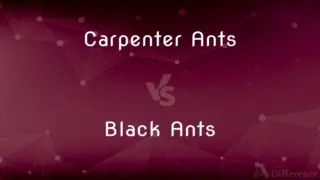Rare vs. Unique — What's the Difference?
By Tayyaba Rehman & Maham Liaqat — Updated on March 4, 2024
Rare refers to something uncommon or infrequent, while unique signifies being the only one of its kind, without any exact duplicates.

Difference Between Rare and Unique
Table of Contents
ADVERTISEMENT
Key Differences
Rare items or occurrences are those that do not happen often or are not widely found in a given context. They are valued for their scarcity and may be sought after because they are unusual. Unique, on the other hand, describes something singular and unmatched in its existence. When something is unique, it means there is nothing else exactly like it anywhere.
The concept of rarity implies a comparison within a larger group or category, suggesting that while rare items are few, they are not solitary. Unique items or situations, however, stand alone in their category, with no comparable peer. This distinction underlines the idea that while all unique items are inherently rare, not all rare items are unique.
The context of collectibles or natural phenomena, a rare object might be one of a few limited pieces or occurrences. Meanwhile, a unique object or event has no identical counterparts, making it one-of-a-kind. For example, a rare painting might be one of a limited series by a famous artist, whereas a unique painting would be the only one of its kind in existence.
The value assigned to rare and unique items can differ significantly. Rare items are often valued for their scarcity and the demand among collectors or enthusiasts. Unique items, however, carry an intrinsic value due to their singularity, often making them priceless or of unparalleled worth.
The use of "rare" and "unique" extends beyond physical items to include experiences and qualities. A person might have a rare skill, meaning few possess it, but a unique perspective is entirely their own, unmatched by anyone else. This usage highlights the adaptability of these terms across different contexts, emphasizing the level of rarity or uniqueness.
ADVERTISEMENT
Comparison Chart
Definition
Uncommon or infrequent in occurrence
Being the only one of its kind
Comparison
Implies scarcity among a larger group
No comparable peers
Examples
Limited edition items, endangered species
One-of-a-kind artwork, unique genetic mutations
Value
Valued for scarcity and demand
Intrinsic value due to singularity
Application
Can apply to items, occurrences, skills
Extends to items, experiences, perspectives
Compare with Definitions
Rare
Less about being singular and more about infrequency.
It's rare to see such a celestial event with the naked eye.
Unique
Carries a sense of absolute singularity.
This sculpture is unique, crafted without any intention of replication.
Rare
Suggests a comparative scarcity within a larger category.
The bird is rare in this region, spotted only a few times each year.
Unique
Often considered priceless or of unparalleled worth due to its uniqueness.
The unique artifact became the museum's most treasured piece.
Rare
Often sought after for its uncommonness.
Rare stamps are highly prized among collectors for their scarcity.
Unique
Implies not just rarity but a one of a kind status.
The artist's technique is unique, developed over decades of practice.
Rare
Something not frequently encountered or seen, valued for its scarcity.
A rare book might be one of only a few copies remaining worldwide.
Unique
Encompasses not only physical items but also qualities and experiences.
His perspective on the matter is unique, shaped by a combination of rare experiences.
Rare
Applies to a wide range of contexts, from collectibles to natural occurrences.
Finding such a rare mineral in this area sparked excitement among geologists.
Unique
The only one of its kind, without any exact duplicates.
Her voice is unique, instantly recognizable among thousands.
Rare
Infrequently occurring; uncommon
A rare event.
A plant that is rare in this region.
Unique
Remarkable; extraordinary
A unique opportunity to buy a house.
Rare
Excellent; extraordinary
A rare sense of honor.
Unique
Being the only one of its kind; unlike anything else
The situation was unique in British politics
Original and unique designs
Rare
Not widely known; especially valued for its uncommonness;
A rare word
Rare books
Unique
A unique person or thing
Some of Lamb's writings were so memorably beautiful as to be uniques in their class
Rare
Not widely distributed;
Rare herbs
Rare patches of gree in the desert
Unique
Being the only one of its kind
The unique existing example of Donne's handwriting.
Rare
Having low density;
Rare gasses
Lightheaded from the rarefied mountain air
Unique
Characteristic only of a particular category or entity
A weather pattern that is unique to coastal areas.
Unique
Highly unusual or rare but not the single instance;
Spoke with a unique accent
Had unique ability in raising funds
A frankness unique in literature
A unique dining experience
Common Curiosities
What does it mean for something to be rare?
Being rare means something is not common or frequently encountered, often making it valuable due to its scarcity.
Is rarity always related to physical objects?
No, rarity can also apply to skills, occurrences, or qualities that are uncommon among a larger group or category.
How is unique different from rare?
Unique refers to being the only one of its kind, with no exact duplicates, whereas rare indicates scarcity among a larger group but not necessarily singularity.
What makes a perspective unique?
A perspective can be unique if it is shaped by a combination of experiences, thoughts, and insights that no one else shares in the exact same way.
Can an item be both rare and unique?
Yes, an item can be both rare and unique if it is not only scarce but also the only one of its kind.
Why are unique items considered valuable?
Unique items carry intrinsic value due to their singularity, often making them priceless or of unparalleled worth.
Is it possible for a book to be unique?
A book can be considered unique if it contains singular content, a one-of-a-kind binding, or autographs that make it the only one of its kind.
How do collectors view rare vs. unique items?
Collectors often value rare items for their scarcity and demand, while unique items are prized for their singularity and irreplaceable nature.
How does rarity affect market value?
Rarity can significantly increase an item's market value, as the fewer items available, the more desirable and valuable they become to collectors and enthusiasts.
What role does uniqueness play in art?
In art, uniqueness is a crucial factor that contributes to the work's value, appeal, and historical significance, making it irreplaceable and often priceless.
What is an example of a unique experience?
Witnessing a once-in-a-lifetime astronomical event from a specific location could be considered a unique experience.
Can a skill be unique?
A skill can be considered unique if it is distinctive and unmatched in its execution or application, though it's more common to describe skills as rare.
Can a natural phenomenon be unique?
Yes, certain natural phenomena can be unique if they occur under specific, unrepeatable conditions, making them one-of-a-kind events.
Why do people seek out rare or unique items?
People seek out rare or unique items for their value, the prestige of owning something scarce or singular, and the personal satisfaction of having something special.
How do businesses leverage rarity and uniqueness?
Businesses often leverage rarity and uniqueness to create demand, enhance branding, and justify premium pricing for products or services.
Share Your Discovery

Previous Comparison
Dope vs. Cocaine
Next Comparison
Aforementioned vs. AforesaidAuthor Spotlight
Written by
Tayyaba RehmanTayyaba Rehman is a distinguished writer, currently serving as a primary contributor to askdifference.com. As a researcher in semantics and etymology, Tayyaba's passion for the complexity of languages and their distinctions has found a perfect home on the platform. Tayyaba delves into the intricacies of language, distinguishing between commonly confused words and phrases, thereby providing clarity for readers worldwide.
Co-written by
Maham Liaqat














































